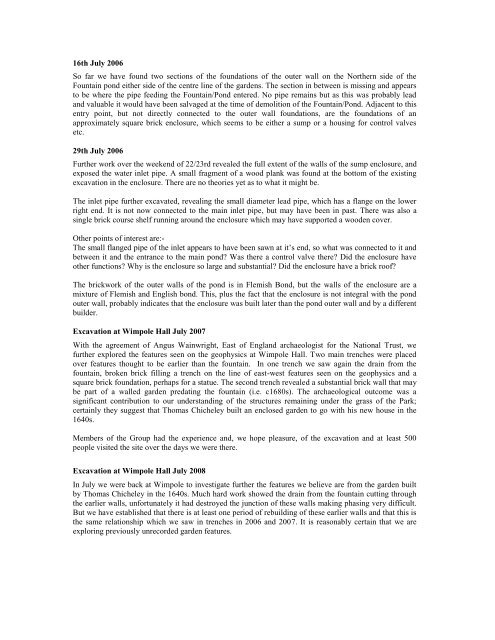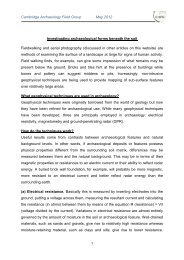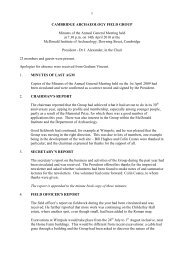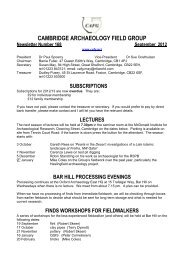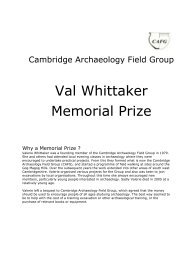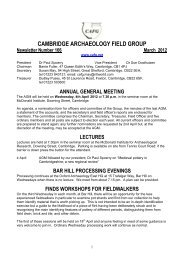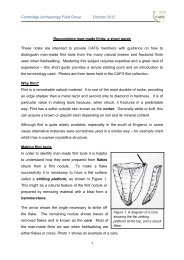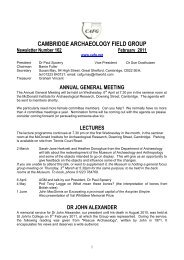Earlier excavations - Cambridge Archaeology Field Group
Earlier excavations - Cambridge Archaeology Field Group
Earlier excavations - Cambridge Archaeology Field Group
Create successful ePaper yourself
Turn your PDF publications into a flip-book with our unique Google optimized e-Paper software.
16th July 2006<br />
So far we have found two sections of the foundations of the outer wall on the Northern side of the<br />
Fountain pond either side of the centre line of the gardens. The section in between is missing and appears<br />
to be where the pipe feeding the Fountain/Pond entered. No pipe remains but as this was probably lead<br />
and valuable it would have been salvaged at the time of demolition of the Fountain/Pond. Adjacent to this<br />
entry point, but not directly connected to the outer wall foundations, are the foundations of an<br />
approximately square brick enclosure, which seems to be either a sump or a housing for control valves<br />
etc.<br />
29th July 2006<br />
Further work over the weekend of 22/23rd revealed the full extent of the walls of the sump enclosure, and<br />
exposed the water inlet pipe. A small fragment of a wood plank was found at the bottom of the existing<br />
excavation in the enclosure. There are no theories yet as to what it might be.<br />
The inlet pipe further excavated, revealing the small diameter lead pipe, which has a flange on the lower<br />
right end. It is not now connected to the main inlet pipe, but may have been in past. There was also a<br />
single brick course shelf running around the enclosure which may have supported a wooden cover.<br />
Other points of interest are:-<br />
The small flanged pipe of the inlet appears to have been sawn at it’s end, so what was connected to it and<br />
between it and the entrance to the main pond? Was there a control valve there? Did the enclosure have<br />
other functions? Why is the enclosure so large and substantial? Did the enclosure have a brick roof?<br />
The brickwork of the outer walls of the pond is in Flemish Bond, but the walls of the enclosure are a<br />
mixture of Flemish and English bond. This, plus the fact that the enclosure is not integral with the pond<br />
outer wall, probably indicates that the enclosure was built later than the pond outer wall and by a different<br />
builder.<br />
Excavation at Wimpole Hall July 2007<br />
With the agreement of Angus Wainwright, East of England archaeologist for the National Trust, we<br />
further explored the features seen on the geophysics at Wimpole Hall. Two main trenches were placed<br />
over features thought to be earlier than the fountain. In one trench we saw again the drain from the<br />
fountain, broken brick filling a trench on the line of east-west features seen on the geophysics and a<br />
square brick foundation, perhaps for a statue. The second trench revealed a substantial brick wall that may<br />
be part of a walled garden predating the fountain (i.e. c1680s). The archaeological outcome was a<br />
significant contribution to our understanding of the structures remaining under the grass of the Park;<br />
certainly they suggest that Thomas Chicheley built an enclosed garden to go with his new house in the<br />
1640s.<br />
Members of the <strong>Group</strong> had the experience and, we hope pleasure, of the excavation and at least 500<br />
people visited the site over the days we were there.<br />
Excavation at Wimpole Hall July 2008<br />
In July we were back at Wimpole to investigate further the features we believe are from the garden built<br />
by Thomas Chicheley in the 1640s. Much hard work showed the drain from the fountain cutting through<br />
the earlier walls, unfortunately it had destroyed the junction of these walls making phasing very difficult.<br />
But we have established that there is at least one period of rebuilding of these earlier walls and that this is<br />
the same relationship which we saw in trenches in 2006 and 2007. It is reasonably certain that we are<br />
exploring previously unrecorded garden features.


